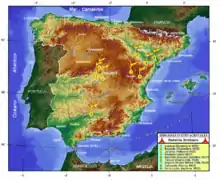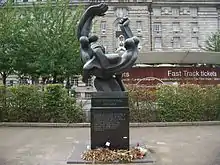British Battalion
The British Battalion (1936–1938) was the 16th battalion of the XV International Brigade, one of the mixed brigades of the International Brigades, during the Spanish Civil War.
| Shapurji Saklatvala Battalion British Battalion | |
|---|---|
| Active | January 1937 – October 1938 |
| Country | |
| Allegiance | |
| Branch | |
| Type | Battalion - Infantry |
| Size | One battalion |
| Part of | XV International Brigade |
| Garrison/HQ | Albacete |
| Nickname(s) | Batallón Británico |
| Engagements | Spanish Civil War |
History

Early volunteers
A number of British volunteers, including Tom Wintringham, David Marshall and Ramona and Nat Cohen, and Scots nurse Annie Murray, arrived in Spain during August–September 1936. The men formed the Tom Mann Centuria, and in July/August they had been part of an attempt to liberate Majorca. Later they were joined by Bill Scott, becoming a rifle company in the German-speaking Thälmann Column. The Thälmann Battalion later formed part of XII International Brigade and fought in the Siege of Madrid, including the Battle of Ciudad Universitaria. [1][2]
Another group of British volunteers – among them Jock Cunningham and John Cornford – fought with the French-speaking Commune de Paris Battalion, in the XI International Brigade. It also fought in the Siege of Madrid, including the battles for University City and Casa de Campo.
In December 1936, 145 British volunteers formed No. 1 Company of the French-speaking Marseillaise Battalion, part of the XIV International Brigade. They fought on the Córdoba front during December, and on the Madrid front during January 1937. Heavy fighting on 15 January at Las Rozas reduced the active ranks to 67.
Formation
In January 1937, the survivors of No.1 Company joined with 450 new British, Irish, and Dominion volunteers at Madrigueras, near Albacete, International Brigades headquarters. They were formed into an English-speaking battalion, with three infantry companies (Nos. 1, 3, 4) and a machine-gun company (no. 2). Canadian Bert "Yank" Levy served as an officer in No.2 company of the Saklatvala Battalion, under Wintringham from 1937. He was captured at the Battle of Jarama and spent six months in a Francoist gaol until he was released in a prisoner exchange.
The battalion was numbered the 16th battalion of the International Brigades. It was formally named after Shapurji Saklatvala, the former Communist Member of Parliament (MP) for Battersea. However, this name never caught on and it was normally known as the "British Battalion". The Spanish also referred to it as "el batallón británico" or "el batallón inglés". Number 1 company was later called the Major Attlee Company after the leader of the British Labour Party, who visited the British volunteers in December 1937.
The British Battalion was attached to XV International Brigade, XV IB. The other battalions were the US Lincoln Battalion, the crack Balkan Dimitrov Battalion, and the Franco-Belgian Sixth February Battalion.
Jarama, 1937
In February 1937, the battalion fought at the Battle of Jarama. In a single day's bloody fighting on 12 February against Moors from Francisco Franco's Army of Africa, the British Battalion suffered 275 casualties in No.1, No.3, and No.4 companies – leaving 125 rifleman fit for duty. On the second day of fighting, the machine gun company was surrounded by Spanish Nationalist troops and many of its members were captured. Battalion commander Tom Wintringham was injured, and Jock Cunningham took command of the battalion's 140 survivors. The battalion remained in the trenches at Jarama until 17 June 1937.
Brunete, 1937
Reinforced by new recruits and strengthened by returnees from hospital, the British Battalion mustered 331 brigaders at the Battle of Brunete. On 6 July, XV IB occupied the villages of Romanillos and Boadilla del Monte, and by midnight captured the village of Villanueva de la Cañada. (It was here that Alex McDade who wrote the song, Valley of Jarama, commonly heard at Brigade reunions, was killed in action.) The following day the British were ordered to advance on Mosquito Ridge, a piece of high ground which overlooked the battalion's original objectives. As they left Villanueva de la Cañada they were bombed by Junkers aircraft from the Condor Legion and shelled by Nationalist artillery. The two-hour barrage and devastating heat caused heavy casualties and prevented the battalion reaching Mosquito Ridge before Franco's army rushed reinforcements to defend the position. Only 42 members of the battalion were left fit for service, and the battalion was withdrawn into a reserve position.
Aragon, 1937
In mid-August, the Republican 35th Division, which included XV IB, was moved to Aragon. The focus of the Aragon campaign was to draw-off Nationalist attacks on Santander and to capture the strategic city of Zaragoza. On 25 August the battalion took part in street fighting to capture the Nationalist strongpoint at Quinto, where Wintringham, now head of the Officer's School and attached to the American Lincoln and Canadian MacKenzie/Papineau battalions, was shot again, this time badly and injured out of the war. On 25 August the battalion attacked a strong Francoist position at Purburrel Hill, and was repelled by intense rifle and machine gun fire. The following day another assault was made on the hill, supported by the XVth Brigade antitank artillery battery, and this time the attack succeeded. Heavy fighting had reduced the battalion to 100 men, and a number of Spanish Republican troops were drafted as reinforcements for the battalion.
Teruel, 1938
Ebro, 1938
Disbandment
On 21 September 1938, Juan Negrín announced to the League of Nations that the Republican government would disband the International Brigades. The British battalion was withdrawn into reserve at the end of September 1938, and on 17 October, the battalion took part in the International Brigades' farewell parade through Barcelona. President Azaña and Prime Minister Negrín joined the crowds who took part in one of the last great Republican celebrations. On disbandment, 305 British volunteers left Spain. They arrived at Victoria Station on 7 December, to be met by a crowd of supporters including Clement Attlee, Stafford Cripps, Willie Gallacher, and Will Lawther.
Welsh members
An estimated 300 people from Wales enlisted in the International Brigades, fighting Franco in Spain from 1936–39. Of the battalion’s 170 Welsh volunteers, 116 were miners, one in five was married and the average age was over 30. The South Wales miners provided the largest regional group in the British battalion.[3][4]
Scottish members
.jpg.webp)
An estimated 500 volunteers went from Scotland to Spain to oppose fascism and support the Republican government there. A high proportion were working class members of the Communist party (which organised the mobilisation and transportation across France), many went in on foot over the Pyrenees.[5] A Scottish Ambulance Unit was also sent to Spain, it dispensed food donations but mainly provided first aid and treatment of the wounded from the front.[5]

International Brigade Memorial Trust
The International Brigade Memorial Trust has been established by veterans and historians to preserve and catalog the history of the British Battalion.
Roll of Honour
The IBMT has compiled a Roll of Honour, listing the members of the British battalion who fell in Spain. The list is compiled primarily from documents held in the International Brigade Archive in the Marx Memorial Library, London and the International Brigade Archive in the Russian Centre for the Preservation and Study of Recent Historical Documents, Moscow.
Notable members
- Bill Alexander – industrial chemist, commander of the British Battalion from 1938, later Assistant General Secretary of the Communist Party of Great Britain.
- Christopher Caudwell – journalist, poet, killed in action at Jarama.
- Lewis Clive – Olympic gold medallist for rowing.
- Fred Copeman – former sailor, organiser of the Invergordon Mutiny, commanded the British Battalion during 1937.
- John Cornford – poet, killed in uncertain circumstances at Lopera, near Córdoba
- Jason Gurney – British sculptor, also served with the Lincoln Battalion.
- Len Crome – doctor, neuropathologist, winner of the Military Cross during the Second World War.
- Jack Jones – later General Secretary of the Transport & General Workers Union.
- Laurie Lee – poet, novelist, author of As I Walked Out One Midsummer Morning, a memoir which covers his experiences.
- Bert "Yank" Levy who used his experience to teach the British Home Guard and wrote a text on guerrilla warfare[6][7]
- Will Paynter – NUM General Secretary 1959 – 1968
- Esmond Romilly – journalist, nephew of Winston Churchill.
- Stephen Spender – poet, essayist, professor at University College, London, knighted 1983.
- Alfred Sherman – Conservative philosopher, battalion Russian translator; taken prisoner in 1938.
- Wally Tapsell - political commissioner, killed in action in 1938.
- Tom Wintringham – journalist, author, commander of the British Battalion to 1937.
- Annie Murray - Scottish nurse, one of the first British volunteers, in September 1936, returned accompanying the injured in 1939.
Further reading
- British Volunteers for Liberty: Spain, 1936–39, Bill Alexander, Lawrence & Wishart, 1983, ISBN 0-85315-564-X.
- No to Franco, the Struggle Never Stopped, 1939–1975, Bill Alexander, 1992, ISBN 0-9519667-0-7.
- British Volunteers in the Spanish Civil War, Richard Baxell, Routledge, 2004, ISBN 0-203-64785-8.
- The Shallow Grave: Memoir of the Spanish Civil War, Walter Gregory, Gollancz, 1986, ISBN 0-575-03790-3.
- Reason in Revolt, Fred Copeman, Blandford Press, 1948. (Out of print)
- Britons in Spain – The History of the British Battalion of the XVTH International Brigade, William Rust, Lawrence & Wishart, 1939.
- Crusade in Spain, Jason Gurney, Faber. 1974. ISBN 978-0-571-10310-2
- We Cannot Park on Both Sides: Reading volunteers in the Spanish Civil War 1936–39, Mike Cooper and Ray Parkes, Reading International Brigades Memorial Committee, 2000. ISBN 0-9535448-0-X.
- Miners Against Fascism: Wales and the Spanish civil war, Hywel Francis, Lawrence & Wishart Ltd, 1984, ISBN 978-0853155775, 2012, Paperback 320pp
- Bradley, Ken International Brigades in Spain 1936–39 with Mike Chappell (Illustrator) Published by Elite. ISBN 978-1855323674. Good basic introduction to the subject in a readable and well-illustrated format. Author made several visits to battlefields and interviewed veterans in the 1980s and 90’s.
- Voices from the Spanish Civil War: personal recollections of Scottish Volunteers in Republican Spain 1936-39 MacDougall, Ian. Polygon Edinburgh, 1986 ISBN 0-948275-19-7
See also
References
- Sugarman, Martin. "Against Fascism – Jews who served in The International Brigade in the Spanish Civil War" (PDF). Jewish Virtual Library. Retrieved April 16, 2014.
- Baxell, Richard (September 6, 2012). Unlikely Warriors: The British in the Spanish Civil War and the Struggle Against Fascism (Hardcover). London: Aurum Press Limited. pp. 400. ISBN 1845136977.
- Durham and South Wales Miners and the Spanish Civil War, Lewis Mates, Durham University, abstract, from: Twentieth Century British History, 2006,pp.373
- INTERNATIONAL BRIGADE MEMORIAL TRUST Issue 15 / September 2006 Archived September 27, 2013, at the Wayback Machine
- Voices from the Spanish Civil War : personal recollections of Scottish volunteers in Republican Spain, 1936-39. MacDougall, Ian. Edinburgh [Lothian]: Polygon. 1986. pp. Foreword pp x, Introduction pp 4, pp 69-76, 78. ISBN 0948275197. OCLC 18835004.CS1 maint: others (link)
- Levine, Allan E. "Bert "Yank" Levy". American National Biography on line. Oxford University Press. Retrieved April 16, 2014.
- Levy, Bert "Yank"; Wintringham, Tom (Foreword) (1964) [1942]. Guerilla Warfare (PDF). Paladin Press. Archived from the original (PDF) on April 12, 2014. Retrieved April 15, 2014.
External links
- British Battalion at International Brigades in Spain
- British International Brigade veterans tell their stories – The Guardian
- The International Brigade Memorial Trust – www.international-brigades.org.uk
- History of the British Battalion, XV International Brigade – www.spartacus-educational.com/
- Irish vol. in SCW
- RealAudio interviews with British Battalion veterans – www.iwm.org.uk
- Men who fought Franco fêted as Spain finally confronts its past – The Times, 15 July 2006
- flyer for 75th Anniversary Gala, showing banner listing battles
